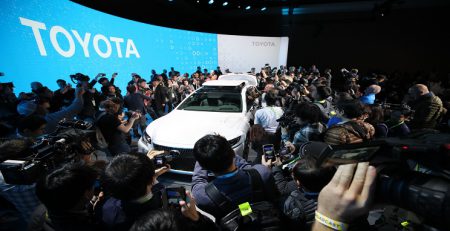Improving Africa’s connectivity: more subsea cables are a good start
Over the last two decades, submarine cables have become a key growth enabler for trade and communication between Africa and the rest of the world. Subsea cables play this role elsewhere, but the effect is newer in Africa.
With recent investments, Africa’s position has improved: stark declines in the price of international capacity have supported a surge in the volume of data consumed, generated, transmitted, cloud-hosted and processed real-time over Africa’s communication networks.
But does Africa have enough capacity?
Traffic and subscriptions have exploded; for instance, mobile broadband users in Africa reached 253 million in 2017, from 22M in 2011. Keeping up with this growth momentum requires continual investments in international connectivity. This article explores recent submarine developments in Africa, identifies bottlenecks, and discusses how they can be addressed.
54 countries and not enough fiber to go around…yet
With 54 countries recognized by United Nations, Africa has 38 countries with a coastline and 16 that are land-locked. The pace of regulatory liberalization, sophistication of telecom infrastructure, and geopolitical stability is quite uneven across the continent. Much of the African growth journey is confined to 10-15 countries. However, this is set to change. Africa’s boom in the construction of new submarine cables is serving as a growth catalyst for regional terrestrial fiber networks connecting multiple countries, fully or partly funded by institutions like African Development Bank (ADB) and other investors.
These investors hope improved international connectivity can create a better business climate for development, reducing prices. As an example of Africa’s challenges, consider the price of a 100G IP port. In London, it available for a monthly recurring charge of $15,000-20,000. Even in South Africa – the most affordable African destination – a 100G port costs 5X higher. This stifles business viability and compels ISPs, MNOs and MSPs to deploy Nx10G incrementally, forfeiting economies of scale.
30 operational cables serve Africa, across 4 corridors
Africa’s cables cover four connectivity corridors – Africa-Europe, Africa-Latam-US, Africa-Asia and Africa-in-region.
Out of Africa’s 38 countries with seashore, 37 countries have at least one submarine cable landing, including 30 operational, and 7 under construction. The best connected country is Egypt, which lands 15 submarine cables. It’s far more common to have just one cable landing, though. Nine African countries face this dilemma, including the Republic of Congo, Togo, Liberia, Sierra Leone, Guinea, Guinea-Bissau, Gambia, Mauritania, and Sao Tome & Principle. Figure 1 illustrates the distribution of subsea cable landing stations in Africa.
Figure 1
Source: MTN Consulting, LLC
The Djibouti hub needs improved terrestrial connectivity
While the count of 30 submarine cables is an impressive figure, most of the upstream IP connectivity is served by 9 submarine cables. One reason for this is, 13 of the 30 cables are basically passing through Africa to Europe via Djibouti and Egypt, as depicted in Figure 2 below.
Figure 2
Source: Submarine Cable Map 2017
Most of these cables play little role in the African economy. Djibouti, despite being close to Kenya and landing 11 submarine cables, remains isolated from rest of Africa. One reason for this is lack of fiber infrastructure connecting Djibouti and Egypt to other African countries. Ethio Telecom, the incumbent in neighbouring Ethiopia, has made things worse by showing little apparent interest in expanding connectivity.
July 2018 brought good news, though: Liquid Telecom announced that it would expand its growing pan-Africa network north into Egypt, signing an MoU with Telecom Egypt to link its network from Sudan north into Telecom Egypt’s network via a new cross border interconnection. That will create a 60,000km km fiber network from Cape Town to Cairo, sometimes called the “One Africa” broadband network (see figure, below).
Figure 3
Source: Liquid Telecom
Multiple weaknesses exist in Africa’s international connectivity
“One Africa” will improve things around Djibouti, but that’s just one of many issues. Africa’s international connectivity needs a number of other improvements:
- more submarine cables with open access cable landing stations,
- multi-provider terrestrial backhaul options,
- fair-play interconnect with other submarine cable systems,
- carrier neutral datacenters and Internet exchanges for traffic localization,
- deployment of network automation with software controls
To sustain the continent’s growth momentum, Africa’s network operators need to address these issues over the next 3-5 years. Fortunately, they are making progress.
Africa’s cable boom is driving higher end user bandwidth requirements
Africa’s new cables are beginning to change the definition of a “high” and “low” capacity customer.
Globally, 1G is becoming the new STM1 and increasingly deployed for enterprise connectivity. 10G is the new STM4, and select markets are ready for the 100G leap (“replacing”) STM16 in 2019-20. While Africa is a year or two behind, outside South Africa, the pace of transformation is set to accelerate in 2019-20. That is evident from recently 100G network upgrades undertaken by Liquid Telecom, SEACOM, EASSy and MainOne. Also, AAE1 announced it would upgrade to 200G last month. This comes just 18 months after the cable was ready for service (RFS), and 2 years ahead of schedule. (Figure 4)
Figure 4
Source: AAE1
Webscale network operators are now big in submarine; is South Africa the next stop?
The global submarine cable market is transforming rapidly due to participation from Google, Facebook, Amazon and Microsoft. Put together this group has already invested in 21 submarine cables globally, the majority in 2015-20 period. The only regions where they are yet to invest in submarine cables is the Asia-Europe corridor, Middle East and Africa. These companies are laying the groundwork, though:
- Microsoft and Amazon have edge network nodes in South Africa and work is underway for cloud datacenters with Teraco to be operational by mid-2019.
- Google and Microsoft have conducted multiple pilot projects across Africa in the last 3 years to bring affordable Internet to underserved regions.
- Facebook and Amazon are reportedly scouting for partners for submarine cable builds and announcements are expected in early 2019.
Given their long term plans, it’s likely that the deep pocketed webscale players will soon start to expand their massive hyperscale networks (including new submarine cables) in South Africa in 2019-20. These new cables will have a far-reaching impact on the continent, especially when combined with the terrestrial reach of the One Africa network.
One challenge is that, even if a new cable project is announced and funded in 2019, it would not likely be operational before 2022. The webscale operators are likely to engage in a number of partnerships to meet their capacity needs in the interim. For instance, they may consider linkups with Liquid, MTN, and Orange for west Africa, and SEACOM or EASSy for east Africa.
Complimenting submarine cables with terrestrial networks and datacenters
Submarine cables alone cannot alleviate Africa’s connectivity challenges. They have to be complimented with multi-provider terrestrial fiber networks with cross-border alliances to make regional connectivity “affordable” – where a reasonable target is 1G links priced below $5000 per month, and declining by 15% per year.
Along the western coast of southern Africa, Angola, Nigeria, Ghana, Ivory Coast and Morocco have multiple providers developing terrestrial fiber networks, but cautiously with limited reach. Pricing remains high, inhibiting deployment of 1G and 10G links.
The situation is better on the eastern side of southern Africa, including South Africa, Mozambique, Tanzania, Kenya, Uganda, Zimbabwe and Zambia: multiple regional providers are developing fiber footprints with increasing capillarity. Liquid Telecom, Simbanet, WIOCC and SEACOM lead the market. The capacity pricing is competitive, low enough to trigger widespread usage of 1G and 10G links for the largest mobile network operators. By 2022, the entry of cloud and content provider-sponsored cable projects will trigger steeper price declines and stimulate demand.
Africa also needs datacenters that are truly carrier-neutral, and not selective about their neutrality. Developments in this area include:
- Teraco in South Africa has datacenters in Johannesburg, Cape Town and Durban, and is at the forefront of the carrier-neutral space. That makes it an attractive acquisition target for a company like Equinix to jumpstart its Africa presence.
- First generation datacenters, supposedly carrier neutral, are also operational in Kenya and Nigeria, with Tanzania, Uganda, Ghana and Ivory Coast lined up for 2019.
- A new breed of focused datacenter providers like Rack Center, Rack Africa and Djibouti Data Center (DDC) are gaining traction. Their facilities, though, may need to be retrofitted to support technical requirements of the big webscale players.
Kenya and Nigeria poised for big changes in 2019-20
For connected-Africa to be a reality, the playground of new submarine cables, terrestrial networks and datacenters must move beyond South Africa. The two countries set to gain prominence in 2019-20 are Kenya and Nigeria. Both countries land 6 submarine cables each, but differ significantly in terms of cross-border terrestrial fiber connectivity.
Figure 5
Source: https://ian.macky.net/pat/map/afri/afriblu2.gif
Kenya has a distinct lead with robust regional connectivity to Uganda, Tanzania and Rwanda through Liquid Telecom and Simbanet. That is being extended to Malawi, South Sudan, Ethiopia and Djibouti. WIOCC and SEACOM have also created terrestrial routes mirroring their subsea routes to provide connectivity to land locked countries. The provider oligopoly however keeps the market price of 1G and 10G links intimidatingly high.
Nigeria is lagging with respect to regional fiber connectivity. That’s despite the fact that Nigerian operators MainOne and Glo-1 own and operate private submarine cables from Nigeria to Portugal and the UK respectively. MainOne has pursued expansion through Camtel and Orange into Cameroon, Cote D’Ivoire and Senegal. Adding that to its existing links in to Nigeria and Ghana, along with cross-border fiber connectivity to 5 adjoining countries, gives MainOne a regional network spanning 10 countries. For its part, Glo1 operates only in Nigeria and Ghana; its recent focus was developing the Glo2 project, a domestic extension to address the Oil & Gas segment.
Webscale the big open question
Africa has made lots of strides in its international fiber connectivity over the last few years, but has far to go. Impending entry by the globe’s big webscale operators is likely to have a big impact on many markets by 2022, and the effect will filter across Africa in the years after. Between now and then, a lot will happen. One thing to watch is how webscale operators link up with regional telcos and carrier-neutral providers to accelerate their network expansion. Such partnerships happen in other regions too, but Africa will require more of them.
Cover image: Cape Town, South Africa (credit: Dan Grinwis)











